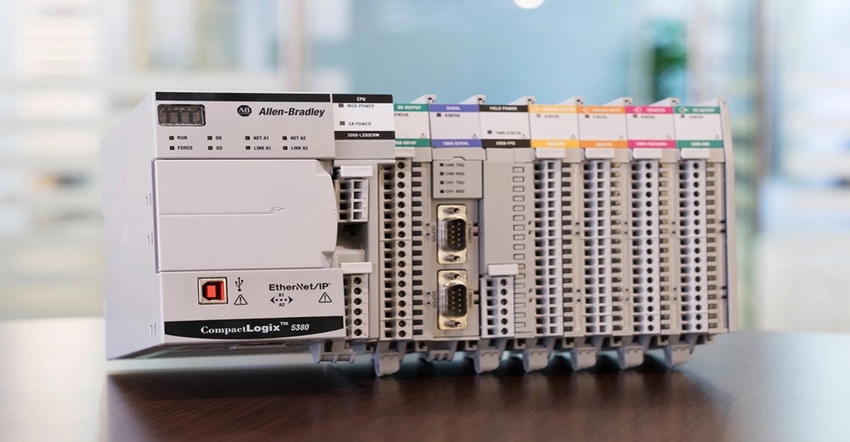Here are some practical details on effective ways to get the most out of PLCs in automation systems.
November 30, 2021

PLCs are used to control, measure, and carry out tasks in complex manufacturing and industrial applications. They work well with other systems, including PCs, PACs (programmable automation controllers), motion control devices, and HMI.
PLCs are fast, easy to operate, and they are considered easy to program. They can be programmed in several ways, from ladder logic, which is based on electromechanical relays, to specially adapted programming languages of BASIC and C, just to name a few.
We checked in with Kristopher Dornan, process control engineer and marketing manager at Rockwell Automation to get a practical view of the value of PLCs in automation.
Design News: How do your customers use PLCs?
Kristopher Dornan: Customers use PLCs to automate industrial tasks. A PLC acts as a brain that receives inputs from sensors and instrumentation such as tank levels, reactor temperatures, and pressures, conveyor speeds, and controls outputs that drive valves to open or close, or heaters to turn on or off.
Increasingly, companies are trying to get more from PLCs. For example, they’re interested in having an industrial control system and Windows operating system together in the same platform. This allows them to run applications like data collection, predictive computations, and analytics at the machine level to help drive better decision-making on the plant floor.
Companies are also looking for ways to integrate machine and robot control systems as they increase their use of industrial robots. There are different ways to achieve this integration. One is to connect them via EtherNet/IP. Another is to combine them into a single, unified control system. Robots that are fully integrated as a core part of the control system can help companies speed up deployments, create faster and more flexible production lines, and help protect workers by reducing exposure to safety risks.
DN: In using PLCs, what are the overall goals?
Kristopher Dornan: By automating industrial processes, companies can reduce time to market, ease the burdens put on an increasingly strained workforce, and drive a more consistent and higher-quality product.
Companies are also trying to unlock new possibilities in their operations with digital transformation, and the PLC plays a central role. For example, when control and computing hardware are combined into one platform, companies can give operators access to data right at its source. And better coordination between robot and machine control systems can help make operators more productive, especially if they spend a lot of time today on activities like mechanical adjustments and equipment synchronization for changeovers.
DN: Do you help with the design and the selection of PLCs? And what are some of the decisions involved?
Kristopher Dornan: As a manufacturer of PLCs, Rockwell Automation does anticipate the different needs of our customers by building modern controllers that use new technology and are scalable to provide the right system at the right cost. We differentiate in this market by offering controllers that can scale up or down and handle both analog (slow) and discrete (fast) functions, so a plant can be entirely controlled by a Rockwell Automation system. Many of these decisions are based on factors like a system’s capabilities and total cost of ownership, which includes maintenance and support.
DN: What troubleshooting is involved in developing the PLC system?
Kristopher Dornan: Commissioning a system is the best way to answer this question. Commissioning is the process of ensuring the functionality of the system before it is used or activated to control live production. In this process, outputs and inputs are simulated to determine that the PLC responds as planned.
More companies are realizing the benefits of virtual commissioning. This involves using a digital model and simulation of a machine to perform controls testing before a machine is even built. Virtual commissioning can help companies successfully validate and debug machines while keeping launches on track – or even accelerating them.
DN: What are the quality checks?
Kristopher Dornan: Numerous quality checks happen either at commissioning or during the active lifecycle of the system. PLCs as well as the inputs and outputs that collect and send information have onboard diagnostics that consistently self-check their capability to function as desired. Based on the criticality of that need, we also offer high availability solutions including redundancy to help eliminate single points of failure.
DN: How involved are you with the PLCs after deployment?
Kristopher Dornan: We get involved based on how customers want our support after commissioning. Our support model is scalable. It can start with just spare-part management and phone and/or online technical support. And it can scale up to full remote-monitoring support, where we completely manage the system and support it without any involvement of the customer. We can also help customers migrate or modernize their aging and obsolete control systems. For example, since discontinuing the PLC-5 controllers, we’ve helped customers modernize to a high-performance PLC that can help them create a Connected Enterprise, which makes digital transformation possible.
About the Author(s)
You May Also Like





